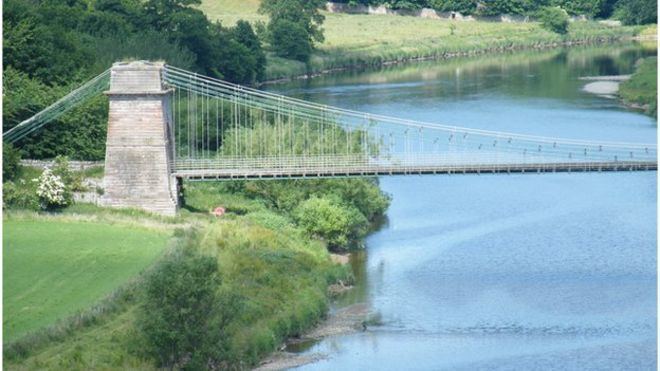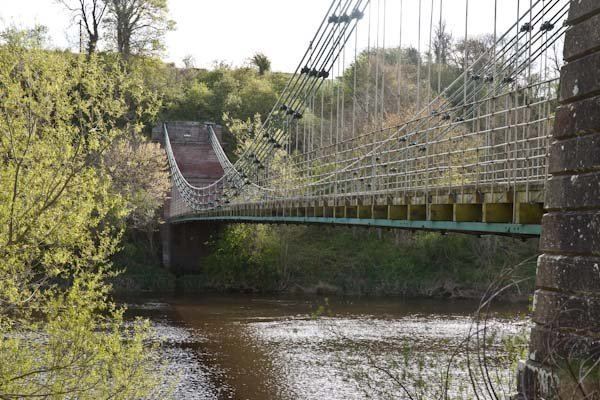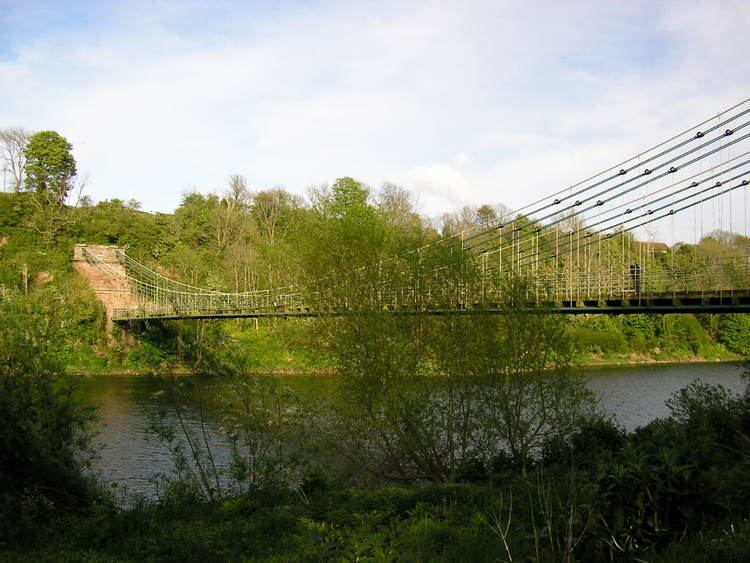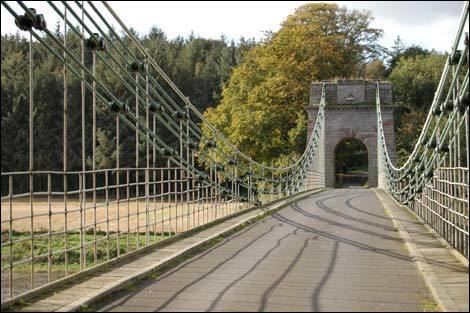Crosses River Tweed Designer Captain Samuel Brown Total length 137 m Location Northumberland Bridge type Suspension bridge | No. of spans 1 Construction begin 1819 Opened 26 July 1820 Engineer Samuel Brown Architect Samuel Brown | |
 | ||
Similar Tweed Bridge, Coldstream Bridge, Ladykirk and Norham, Kelso Bridge, Drygrange Old Bridge | ||
The Union Bridge, also known as the Union Suspension Bridge or Union Chain Bridge, is a suspension bridge that spans the River Tweed between Horncliffe, Northumberland, England and Fishwick, Berwickshire, Scotland. In so doing it also spans the border between England and Scotland. When it opened in 1820 it was the longest wrought iron suspension bridge in the world with a span of 137 metres (449 ft), and the first vehicular bridge of its type in United Kingdom.
Contents

Although work started on the Menai Suspension Bridge first, the Union Bridge was completed earlier. Today it is the oldest suspension bridge still carrying road traffic. It lies on Sustrans Route 1 and the Pennine Cycleway.

History

Before the opening of the Union Bridge, crossing the river at this point involved an 11-mile (18 km) round trip via Berwick-upon-Tweed downstream or a 20-mile (32 km) trip via Coldstream upstream. (Ladykirk and Norham Bridge did not open until 1888.)
Construction

The bridge was designed by an English Royal Navy officer, Captain Samuel Brown. Brown joined the Navy in 1795, and seeing the need for an improvement on the hemp ropes used, which frequently failed with resulting loss to shipping, he employed blacksmiths to create experimental wrought iron chains. The HMS Penelope was fitted with iron rigging in 1806, and in a test voyage proved successful enough that in 1808, with his cousin Samuel Lenox, he set up a company that would become Brown Lenox & Co. Brown left the Navy in 1812, and in 1813 he built a prototype suspension bridge of 105 feet (32 m) span, using 296 stone (1,880 kg) of iron. It was sufficiently strong to support a carriage, and John Rennie and Thomas Telford reported favourably upon it.

Brown took out a patent in 1816 for a method of manufacturing chains, followed by a patent titled Construction of a Bridge by the Formation and Uniting of its Component Parts in July 1817. In around 1817, Brown proposed a 1,000 feet (300 m) span bridge over the River Mersey at Runcorn, but this bridge was not built. It is not known why Brown became involved with the Union Bridge project, but agreed to take on the work based on a specification dated September 1818.

The Dryburgh Abbey Bridge, a cable-stayed footbridge further upstream, had collapsed in January 1818, shortly before construction of the Union Bridge commenced.
Brown knew little of masonry, and Rennie did this aspect of the work.
The bridge proposal received consent in July 1819, with the authority of an Act of Parliament that had been passed in 1802, and construction began on 2 August 1819.
It opened on 26 July the following year, with an opening ceremony attended by the celebrated Scottish civil engineer Robert Stevenson among others. Captain Brown tested the bridge in a curricle towing twelve carts, before a crowd of about 700 spectators crossed. Until 1885, tolls were charged for crossing the bridge; the toll cottage, being at the English end, was demolished in 1955.
Later history
With the abolition of turnpike tolls in 1883, maintenance of the bridge passed to the Tweed Bridges Trust. When the Trust was wound up, the bridge became the responsibility of Scottish Borders Council and Northumberland County Council and it is now maintained by the County Council.
In addition to the 1902 addition of cables, the bridge has been strengthened and refurbished on many occasions. The bridge deck was substantially renewed in 1871, and again in 1974, with the chains reinforced at intervals throughout its life.
The bridge was closed to motor vehicles for several months during 2007. A newspaper report available online (see external links) indicates that the closure happened shortly before 12 April 2007 and was due to one of the bridge hangers breaking. The affected hanger has temporarily been replaced with threaded bar to allow the bridge to reopen to motor vehicles.
In December 2008 the bridge was closed to traffic as a result of a landslide. In March 2013 it was reported that the bridge was proposed to be closed because of a lack of funds to maintain it. In October 2014, it was reported that local enthusiasts and activists had started a campaign to have the bridge fully restored in time for its bicentenary in 2020.
The bridge is a Category A listed building in Scotland and a Grade I listed building in England.
Design
The bridge has a single span of 449 feet (137 m).
It runs on an east-west alignment, with the eastern end in Scotland and the western end in England. At the Scottish end the road continues straight, but at the English end it turns sharply south.
